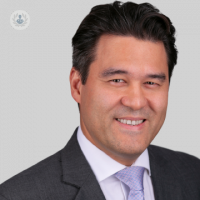Craniosynostosis: impaired skull and brain growth
Escrito por:Craniosynostosis is a condition that can affect the shape and size of a baby’s head, leading to further complications if left untreated. Mr Juling Ong clarifies what craniosynostosis is along with important information to know should your baby be affected.

What is craniosynostosis?
Craniosynostosis is a condition that can affect the shape and size of your baby’s head. The skull is made up of plates of bone with fibrous joints called sutures and these allow a small amount of movement. This movement is important to help with the passage of a baby’s head through the pelvis during childbirth and to allow the skull to accommodate the rapidly growing brain in your baby’s early years of life. Craniosynostosis is when these sutures fuse and become bone earlier than normal. It is important to make the diagnosis as early as possible in children with craniosynostosis so that any problems that are associated with this condition can be detected, prevented and treated in a timely manner.
How do I know if my baby has craniosynostosis or if the shape of their head is normal?
As the shape and size of babies’ heads can change during the first few months of life, it can be difficult for you to detect if your child’s particular head shape is due to craniosynostosis. As many types of craniosynostosis have a particular shape, an examination by a craniofacial surgeon in most cases is able to diagnose this condition, or reassure you that your child’s head shape is normal. Very occasionally, further investigations may be useful in monitoring head and brain growth.
What is the outlook like?
With the right care, the outlook for children with craniosynostosis is good with most children growing up to live normal productive lives. Some children have more than one suture affected by craniosynostosis as part of a genetic syndrome. This is called multi-suture craniosynostosis and is more often associated with other craniofacial anomalies which can affect other vital functions such as breathing, vision, hearing, speaking and feeding. Your craniofacial surgeon will be able to help guide you through the various treatment options that are available for your child’s condition.
Can craniosynostosis cause brain damage?
When diagnosed early, most of the problems associated with craniosynostosis can be prevented or treated. Problems, such as raised pressure in the head (intracranial pressure) are associated with craniosynostosis and can result in neurological injury if left untreated. If your child with craniosynostosis does have raised intracranial pressure, your craniofacial surgeon can advise you on the range of surgical options that are available. It is important to continue to monitor for signs of raised intracranial pressure in almost all children with craniosynostosis for at least the first eight years of life when the brain is still growing.
What is craniosynostosis surgery?
Craniosynostosis surgery covers a range of operations that treat the head and facial differences as well as the functional problems associated with craniosynostosis. Many parents request surgery to re-shape the abnormal head shape associated with craniosynostosis. Your craniofacial surgeon will be able to explain the various options, as well the benefits and risks of each in relation to your child. Their goal will always be to guide you to help you make the best decision for your child.
Is craniosynostosis surgery dangerous?
Surgery for craniosynostosis should only be performed by teams who are experienced in caring for children with this rare condition. These risks will be specific for each patient, but we know that the serious complications can be reduced and surgery made safer and more reliable when teams of experienced surgeons who understand the complexities of this condition work together.
Learn more about Mr Ong’s extensive experience in craniofacial and paediatric plastic surgery and to get in touch with him via his profile.


